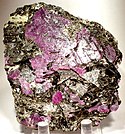Corundite (emery rock), Naxos Emery Deposits Greece
Corundite (emery rock) (broken surface, dry) with corundum/sapphire (blue) and calcite (yellowish-brown).
Corundite is a remarkable metamorphic rock. The sample shown here has an attractive bluish color and wisps of yellow-brown. Its composition and origin are quite unusual. Corundite (a.k.a. emery rock) is dominated by corundum, a very hard (H ≡9) aluminum oxide mineral (Al2O3). This particular rock has blue corundum, therefore it can be called sapphire. Rock-forming corundum is rare.
This material comes from the Naxos Emery Deposits on the island of Naxos in the Aegean Sea. Naxos is dominated by metamorphic rocks and some igneous rocks. Much of the island consists of marbles (originally limestones). Some of the original limestones had lenses of bauxite, which is a rock having aluminum hydroxy-oxide minerals. Upon metamorphism, the limestones were converted to marbles and the bauxites were converted to diasporites (= diaspore (AlO·OH)-dominated rocks).
Upon further metamorphism, the diasporites were converted to corundites plus water. High fluid pressures fractured the rocks, and the fractures got filled up with corundite.
Metamorphism on Naxos occurred during the Cenozoic in two main phases. A high-grade metamorphic event occurred during the Eocene, at about 40-50 million years ago. A second, intermediate-grade metamorphic event occurred during the Early Miocene, at 16-20 million years ago.
Info. synthesized from:
Urai & Feenstra (2001) - Weakening associated with the diaspore-corundum dehydration reaction in metabauxites: an example from Naxos (Greece). Journal of Structural Geology 23: 941-950.
Feenstra & Wunder (2002) - Dehydration of diasporite to corundite in nature and experiment. Geology 30(2): 119-122.Relevante Bilder










































Relevante Artikel
KorundDer Korund ist ein relativ häufig vorkommendes Mineral aus der Mineralklasse der Oxide und Hydroxide. Er kristallisiert im trigonalen Kristallsystem und hat die chemische Zusammensetzung Al2O3, er ist damit chemisch gesehen Aluminiumoxid. .. weiterlesen
